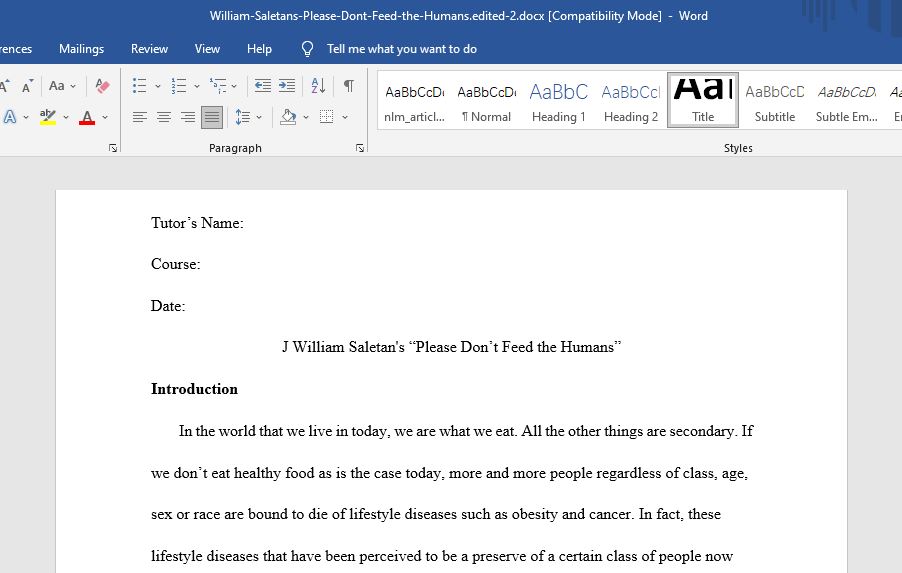J William Saletan’s “Please Don’t Feed the Humans”
The Assignment: Now that you’ve written argumentative essays and are familiar with various writing strategies, you have the skills necessary to write an extended rhetorical analysis. For this assignment, you are to choose an essay from our textbook to analyze. You may not choose an essay we have discussed or used in the past in any way in this class. It must be a new essay to you.
Reason for the Assignment: Although I want you to base your writing on reason, I also want you to have an understanding of how the powers that be—corporations, the government, politicians, pundits, commercials on TV and radio—seek to manipulate us largely through their use of word choice, sentence construction, and logical fallacies. As an educated person, you need to be aware of when this is happening to you.
Things to Consider When Making Your Evaluation:
- Who is the “author?” What is his/her background, education, and expertise?
- What is the author’s thesis/claim? Is it explicit or implicit?
- To whom was this essay written—its target audience? its ideal audience?
- Does the author try to establish common ground with his/her audience?
- What is the author’s tone? Does it change without the article? If so, be able to explain the changes in tone.
- What writing strategies were used? Does the essay make use of emotional, ethical, logical appeals, and/or counter arguments and refutation? Which of these strategies was emphasized? Why you think this emphasis was chosen?
- Does the author make a convincing case? Why or why not?
- How is the article framed?
- Can you locate and identify any logical fallacies by name or particular weaknesses?
- Why do you think these fallacies were used?
- Additionally, notice the authors use of:
a)The Passive Voice: When you don’t want to take responsibility for a crime, you can say “Crimes werecommitted” instead of “I committed a crime” thus suggesting that you had nothing to dowith what actually happened. A war was started, book-keeping errors were made, a testwas failed, bribes were taken—these passive constructions minimize the role of anyone person.
b)Euphemisms:“A word or phrase used in place of a term that might be considered too direct, harsh, unpleasant or offensive” (Encarta World English Dictionary). Often we use euphemisms to be polite when describing bodily functions, sex or other activities that may make us uncomfortable— “Ladies’ Room,” “passing on” instead of “dying,” “attacked” instead of “raped” and so on. However, sometimes euphemisms are used to obfuscate and confuse, to hide what is really going on.
Writing the Essay: Once you have answered all these questions in the first part of the writing process for this assignment, you will then need to work on the focus of your essay and how to include the information you have come up with. Remember, you are trying to evaluate someone else’s work, so you will be looking for strengths and weaknesses.
*You should not focus on whether you agree with the author’s position. You must focus instead on how skillfully the author makes his/her argument.
This essay cannot simply be a cataloguing, list of good and bad points. The trick in writing this paper will be to have a strong focus, which will guide you as you write. You should do as much preparation as you can: reading and evaluating the argument, prewriting and preparing a rough draft.
Organization of the Essay:
Introduction
- Attention grabber: Draw me into the topic of the essay you are critiquing. Make me care.
- Introduction of the essay you are critiquing: give the title and state the author’s name.
- Your thesis statement: Identify whether you believe the essay you are critiquing is effective or ineffective (or both) and offer some main reasons why you believe this.
- Plan of Development: Briefly introduce the topics that you will cover in this paper (tone, evidence, etc.) and your view of them. This should be provide a clear map of your essay.
Body of the EssaySection One
- The thesis of the argument/essay you are evaluating. State whether it is implicit or explicit.
- Prove that the thesis you have asserted is really the thesis of the essay.
Body of the Essay Section Two
- Who is the intended audience? Give proof from the text. There should direct quotes in body paragraph.
- Who is the ideal audience?
- What does the writer hope the audience will do?
Body of the Essay Section Three
- What common values/concerns does the author include would be shared with the ideal audience (common ground)? Make sure you provide proof from the essay.
Body of the Essay Section Four
- Identify and trace the author’s tone about the events and people in the essay. Show the shifting of tone by identifying each. Provide examples to demonstrate what you mean.
- What effect do these shifts have on the reader?
Body of the Essay Section Five
- Discuss the author’s use of pathos, emotional appeals and ethos, appeals to authority (credibility). Be sure to comment on his/her word choices.
- Does the writer use euphemisms? If so, explain their use. What is their intended affect on the essay’s readers?
- Discuss the type of logical support the author uses (experts, statistics, studies, etc.).
- Evaluate the writer’s logic. Do you notice any logical fallacies in the writer’s arguments?
Conclusion
- Restate the author’s purpose: thesis and what he or she hopes the audience will do after completing the article.
- Restate (reword) yourthesis: summarize your evaluation of the essay.
Overall Requirements:
- MLA Format
- Works Cited Page
- Cover Page
- 1500 words/ 6 pages of text (excluding cover and reference sheet)
- Edited and Proofread (without mistakes/grammar or sentence errors)
- Written in third person point of view
- Direct quotes with citations used in all body paragraphs
Answer preview:
Words:1800

